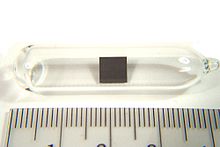Jessie Slater
Jessie Mabel Wilkins Slater (24 February 1879 – 25 December 1961) was an English nuclear physicist who worked as a radiologist at a military hospital in World War I and served as the first woman mayor of Hampstead.
Life
[edit]
Slater was born in Hampstead on 24 February 1879 to John Slater and his wife Mary, née Wilkins. She had two sisters, including geologist Ida Slater.[1]
She studied at Newnham College, Cambridge from 1899 to 1903, and then received a Bathurst studentship to continue her studies in 1903–5.[2] She worked on thorium at the Cavendish Laboratory under J. J. Thomson.[3] She established that the decay products of thorium volatised at different temperatures, and showed that thorium and radium emanations emitted delta rays.[1]
She received her BSc in chemistry from the University of London in 1902,[4] as Cambridge was not awarding degrees to women at the time, and was one of the first women to receive a doctorate in science at the University of London in 1906.[5]
After teaching at Cheltenham Ladies' College from 1909 to 1913, she returned to Newnham as a lecturer in physic and chemistry from 1914 to 1926.[1]
During World War I she worked part-time as a nurse. In 1918, she worked as a radiologist at a British military hospital in France.[1][6]
In June 1926, she married Harold Baily.[7] She served on school care committees and on the Council of Unitarian and Free Christian Churches. She served two terms as mayor of Hampstead in 1930–1 and 1931–2.[8]
She died on 25 December 1961.[1]
Publications
[edit]- Slater, J.M.W. (1905). "LIX. On the excited activity of thorium". The London, Edinburgh, and Dublin Philosophical Magazine and Journal of Science. 9 (53): 628–644. doi:10.1080/14786440509463314. ISSN 1941-5982.
- Slater, J.M.W. (1905). "LIII. On the emission of negative electricity by radium and thorium emanations". The London, Edinburgh, and Dublin Philosophical Magazine and Journal of Science. 10 (58): 460–466. doi:10.1080/14786440509463393. ISSN 1941-5982.
References
[edit]- ^ a b c d e Ogilvie, Marilyn Bailey; Harvey, Joy Dorothy (2000). The Biographical Dictionary of Women in Science: L-Z. Taylor & Francis. p. 1198. ISBN 978-0-415-92040-7.
- ^ Creese, Mary R. S. (1991). "British Women of the Nineteenth and Early Twentieth Centuries Who Contributed to Research in the Chemical Sciences". The British Journal for the History of Science. 24 (3): 275–305. doi:10.1017/S0007087400027370. ISSN 0007-0874. JSTOR 4027231. PMID 11622943.
- ^ Rayner-Canham, Marelene F.; Rayner-Canham, Geoffrey (1997). Devotion to Their Science: Pioneer Women of Radioactivity. McGill-Queen's Press - MQUP. p. 23. ISBN 978-0-7735-1608-3.
- ^ Murray, Janet; Stark, Myra (2017-01-06). The Englishwoman's Review of Social and Industrial Questions: 1903. Routledge. ISBN 978-1-315-39552-4.
- ^ Marshall, Jill (2015-04-03). Women in Physics: A collection of reprints in honor of Melba Newell Phillips. American Association of Physics Teachers. ISBN 978-1-931024-20-4.
- ^ Boyd, Stephanie, ed. (2023), "Cambridge at War", The Story of Cambridge (2 ed.), Cambridge: Cambridge University Press, pp. 137–155, doi:10.1017/9781139981712.008, ISBN 978-1-107-42888-1, retrieved 2024-09-12
- ^ Horton-Smith, Lionel Graham Horton (1951). The Baily Family of Thatcham and Later of Speen and of Newbury, All in the County of Berkshire. W. Thornley. p. 153.
- ^ Arts, Wac (2019-06-17). "World War 1 Nurse became Mayor of Hampstead". Wac Arts. Retrieved 2024-09-12.
